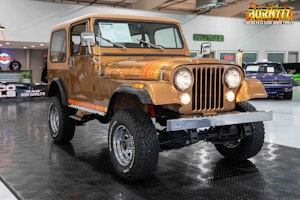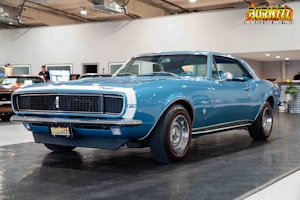Media | Articles
How the Spline Shaped Some of Your Favorite Classic Cars
This story first appeared in the September/October 2024 issue of Hagerty Drivers Club magazine. Join the club to receive our award-winning magazine and enjoy insider access to automotive events, discounts, roadside assistance, and more.
The lexicon of car design includes the coolest names. An abruptly chopped tail is called a Kammback. A rear pillar with a blunted corner is known as a Hofmeister kink. Tumblehome refers to the taper of the greenhouse above the beltline. In my tenure as an automotive design student, I found that if there was a distinct feature or styling element on a car, there was usually a name for it.
But I was driven nuts when I encountered the pronounced ridge that runs the centerline of cars like the 1959 Cadillac El Dorado, 1963 Corvette Coupe, and the boat-tail 1971 Buick Riviera. The ridge was obvious to any observer, but it seemed to have no name. Wikipedia, always a great source, claims it’s called a Batsman crease because it looks like the central ridge on a cricket bat. That sounded plausible, but the only corroborating source was a random poster on a forum for industrial designers. Also, who the hell at the GM design studio in midcentury America was paying attention to cricket?

Further Googling of “Batsman crease” only led to news about cricket matches, so I reached out to Richard Vaughan, a veteran car designer who penned the Lincoln Navigator. “Most designers would call that peaked line a ‘spline’,” he said.
To anyone who has messed around with computer-aided-design (CAD) software or drawn curves with the pen tool in Adobe Creative Suite, this term should sound familiar. I asked Vaughan if the term originated from computer software. It did not: Spline was an old word, he said, carried over from the days of clay models and wooden bucks. This explanation opened up a can of worms.

The Cambridge Dictionary defines spline in two ways: as “a long, thin piece of wood or metal used in construction” and as “a curve that connects particular points.“ Humans have been using splines forever, most notably by bending wood strips to create the complex shapes of boat hulls. As boats got larger and more complex, translating the curved sections of scale models into life-size drawings and parts became increasingly difficult.
Marketplace
Buy and sell classics with confidence


In the early days of the automobile, coachbuilders would typically line up sectioned slats of wood or metal to create a skeleton form, called a buck, around which they would shape the sheetmetal. During the forming process, the panels are repeatedly test-fitted to the buck until they conform exactly to the contours of its curved sections—splines—which define the shape of the car. As automobile production moved from small shops to assembly lines, this method of metal shaping became unwieldy. It didn’t help that the cars themselves were getting curvier, meaning the number and complexity of splines dramatically increased.
French manufacturer Citroën figured out how to define splines mathematically in 1959, which made the process of translating them to factory tooling easier and more precise. Citroën’s mathematical breakthrough was improved upon by Renault and GM, and it became the basis for the CAD software that designers use today. A glance at today’s cars proves that designers are still thinking about splines and often accentuate them by making them proud of the surface, as on the Bugatti Tourbillion (below) or most modern Cadillacs.
The next time you see a CT5-V or ogle a ’71 Riviera, tip your hat to boat builders and French mathematicians.


















Car designer for 30+ years here. I worked at GM design for a decade. I don’t ever recall a central feature like on the cars you mention being called a “spline”. (It’s definitely a term used within the context of software like Autodesk Alias) Far more likely is “spine” which has obvious connections in terms of appearance and functionality. Spine is a term I’ve used regularly over the years, and so have others. “Batman’s crease” is plausibly a term used back in the 50’s or 60’s but may have been such a narrowly used one that it got lost to time for later generations of designers.
FYI my new 2025 Cadillac CT4-V Blackwing has a subtle ‘top’ Spline from the hood to the rear. Amazing.
My 2004 Crossfire has a spine.
https://www.allcarindex.com/concept/united-states/chrysler/crossfire-concept#google_vignette
I’m no autobody designer but have much CAD experience. I used countless splines where I couldn’t use simple radii, and that ridge along the roof of a car looks like an obvious spine to me. And I come across many splines in drive lines. Semantic Man strikes again!
A boat spline helps keep it go straight. It’s a pronounced line just like the ones we see in various vehicles that help the eye follow the length. It also strengthen the body, as any fold/bend does. Calling it a spine is no sacrilege. SSDD.
A spline can be loosely defined as a compound line having two or more tangent radii of opposite curvature. I’ve heard it as “S-curves” before (CAD engineer/ industrial designer since 2001 here). Being that the location shown is centralized (and likely an arc of decreasing radius), “spine” is just as reasonable here.
A very subtle example of this can be found on the rear of 67-68 Mustang fastbacks. It’s even etched into the backlight (rear glass).
Not sure about Citroen inventing the curve. According to this it was invented by Pierre Bézier (hence the Bézier curve found in illustration software) who was a Renault. https://en.wikipedia.org/wiki/Pierre_Bézier
I suppose the spline/spine term is arguable: I think of splines in the form of, say, an axle shaft: for the purpose of positively engaging rotating objects. A spine is how I view the center ridge in the examples cited – and noting its similarity to the animal world – heck, turn around & look at your human back in a mirror…but carry on…
“Spine,” “spline” – the interesting thing to me were the pics of the Cobra buck. Extra points to the know-it-all who can identify the three guys pushing the buck back into the garage: guy on right 1 pt, guy in middle 2pts, and guy on left 5pts. Extra point for id’ing the cars on the lot.
At first glance, I see an Impala and a Corvette…
“Spine” makes more sense to me. “Splines” are generally multiple and intended to eliminate rotation around an axle shaft; whereas, the spine is generally a solitary structure located on the dorsal surface of both animate and inanimate objects.
I have heard it referred to being called a Spine more than a Spline but both have been used. Either way It looks great on the Corvette or the Bugatti.
And the Tatra!
I find it kind of surprising that the iconic spine or central ridge on the Bugatti Type 57 Atlantic manufactured from 1933 – 1938 was not even mentioned anywhere in the article. It was itself based on an earlier concept called the Aerolithe.
If I remember correctly, the reason that Bugatti used the spine was to join the magnesium sheet metal together with rivets, as welding would be especially dangerous. Makes for a very unique appearance!
There was a recent Hagerty Member Story on a 1936 Bugatti Type 57 SC Atlantic replica with a gorgeous spine. see https://www.hagerty.com/media/member-stories/i-fell-in-love-with-prewar-bugattis-so-i-decided-to-build-one-myself/
In the effort to keep the peace, I suppose we can agree that a spine is a central spline. That is, all spines are splines (as defined in the article) but not all splines are spines.
I’m sure the Corvette crowd will be able to weigh in on this but I was of the belief that for the ’63 Sting Ray, that character line and the original window split was intended to make the form look more alive and specifically like the spine of a Sting Ray. (Recall, midyears were called Sting Ray and were reminiscent of the ocean creature. The XP-87 “Stingray Racer” and later XP-755 Mako Shark concept cars evolved into the ’63 Corvette.) The Maco Shark II, which evolved into the ’68 Corvette, had much more shark styling. Thus the ’68 Corvette dropped the Sting Ray moniker. Nonetheless, the Sting Ray name was so iconic, it was resurrected from 1969 through 1976 but now as one word: Stingray. The C7 resurected the name in 2014. and has much more styling influence from the C3 “Sharks” than the C2 “Midyears”.
As a kid in the ’70’s, I remember most cars had a subtle midline crease down the hood and trunk, likely to help stiffen that large flat area of designs of that era.
Just my 2 cents…
I think it’s time to retire both monikers “Sting Ray” and “Stingray”. It would free the automotive stylists at GM from the albatross hung around their necks. The C8 appearance would benefit if relieved of the requisite cartilaginous fish styling cues.
The twin spine/splines on the 1957 Olds/Buick really adds a lot to the roofline of those cars.
During the close to 36 years working as a designer, I have very occasionally heard the cars’ centerline referred to as a “center spline”. Otherwise, the previous comments referring to it as a “spine” make most sense to me.
1967-68 Mustang fastback. Starts mid-roof and continues almost to the bottom edge of the trunk. Even the fastback glass is etched to continue the ‘spline’.